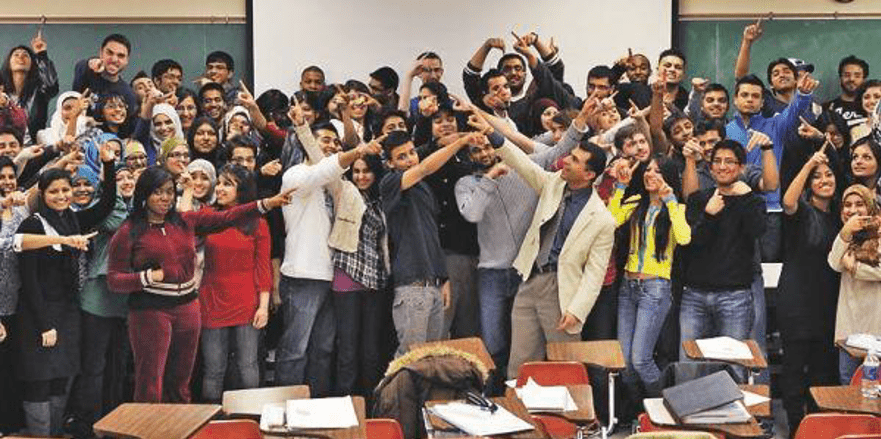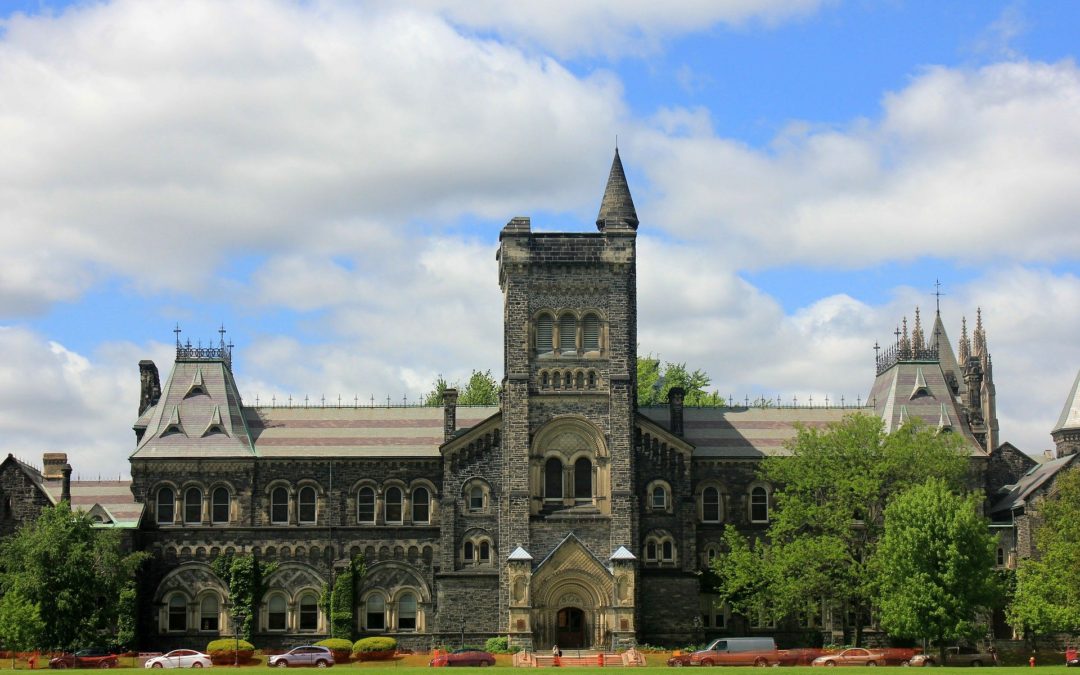
Shafique N. Virani (center), a popular associate professor of Islamic studies at the U. of Toronto, says he has been asked to perform a student’s wedding.
Forget baking cookies. Forget writing a glowing teacher evaluation. Angelica Chavez wanted to do a little something extra to celebrate her favorite public-administration professor, Michael Clarke.
So when the former student at California State University at San Bernardino gained her U.S. citizenship, in 2001, she became Angelica Chavez Clarke.
No, they’re not married, Ms. Clarke is quick to point out. She didn’t get the professor’s permission to adopt the name “Clarke.” She didn’t even think about it far in advance—the idea came to her suddenly.
“I remembered the people who had a lasting impression on me, and Dr. Clarke stood out,” says Ms. Clarke, who is from Mexico. “As the officer said, ‘Would you like to change your name?,’ I thought, Why not Clarke?”
In honor of her professor Michael Clarke (left), of California State U. at San Bernardino, Angelica Chavez added the name “Clarke” to her own when she became a U.S. citizen.
In an age when being a “follower” often means reading somebody’s Twitter feed, sincere gestures of appreciation like Ms. Clarke’s can be edifying for professors—if a bit bewildering. Up-and-coming scholars may dedicate their dissertations or discoveries to their professors, but undergraduates have fewer ways to show their appreciation.
Mr. Clarke, who is Irish, says he was “gobsmacked” when Ms. Clarke told him at a department Christmas party why she had changed her name. “Very, very surprising,” he says. “Out of the blue. Quite frankly, I didn’t know how to respond.”
 
But he has gotten used to the idea and feels “immensely honored.” It is really a tribute to the Cal State system that Ms. Clarke was able to have access to such a great education, he says.
Maybe some college students are so tired of being treated like numbers that they relish making a more personal connection. That’s how Shafique N. Virani, an associate professor of Islamic studies at the University of Toronto, explains the special treatment he’s received from some students.
One brought his entire family to him and “insisted that I sign his textbook,” Mr. Virani says. Another student invited him on an all-expenses-paid tour of Europe. And a third asked him to officiate at her wedding.
“I told her I was honored, but that I’ve never officiated a wedding before,” says Mr. Virani. “That they might want to get somebody with a little bit more experience that wouldn’t mess it up for them on their special day.”
Mr. Virani is also the subject of a more common way for students to celebrate (and poke fun at) their favorite professors: a Facebook fan club. The clubs, which can attract hundreds of members, typically involve a page with a biography of the professor and loosely interpreted humorous quotes from the classroom.
There are fan clubs for Glenn R. Cuomo, of the New College of Florida (“The man, the myth, the legend”); Steven Pinker, of Harvard University (“This is not about his hair. It’s about his ideas”); and Torrance Kirby, a professor of ecclesiastical history at McGill University (“I heard Torrance Kirby and Perpetua had a duel, and it was a draw”).
But true fans aren’t satisfied with digital ephemera. Jay Chen turned a photograph of one of his professors, John L. Diamond, into a red, white, and blue illustration in the style of the famous Obama “hope” poster. Mr. Chen, a student at the University of California’s Hastings College of the Law, replaced the word “hope” with “trap,” a catchphrase the professor is known to shout at bewildered students when tripping them up in a complex legal hypothetical.
At first, Mr. Chen quietly put stickers with the illustration on lampposts around the campus, a kind of “guerrilla art piece,” he says. But after news of the image spread, and students began using it as their Facebook profile picture, he gave in to popular demand and created a John Diamond “Trap” T-shirt. He sold 100 of them.
“Diamond was completely OK with it. He said he was very flattered,” Mr. Chen says. “He actually bought a couple himself.”
Making a T-shirt wasn’t enough for Tony Maher, a photographer and another former student at San Bernardino. Mr. Maher says he learned so much from three of his photography professors that he decided to tattoo their names, with that of a photo editor at a newspaper where he interned, onto his left leg.
The idea wasn’t as far-fetched as it sounds. Mr. Maher has other tattoos, and he sported a green Mohawk for six years to protest the George W. Bush administration.
“You really mean it,” Mr. Maher says of the tattoo, which has the four names and an image of his favorite Rolleiflex camera. “That’s what made me who I am, going through these people’s tutelage.
“It’s more than just sending them a card,” he says.
So when the former student at California State University at San Bernardino gained her U.S. citizenship, in 2001, she became Angelica Chavez Clarke.
No, they’re not married, Ms. Clarke is quick to point out. She didn’t get the professor’s permission to adopt the name “Clarke.” She didn’t even think about it far in advance—the idea came to her suddenly.
“I remembered the people who had a lasting impression on me, and Dr. Clarke stood out,” says Ms. Clarke, who is from Mexico. “As the officer said, ‘Would you like to change your name?,’ I thought, Why not Clarke?”
In honor of her professor Michael Clarke (left), of California State U. at San Bernardino, Angelica Chavez added the name “Clarke” to her own when she became a U.S. citizen.
In an age when being a “follower” often means reading somebody’s Twitter feed, sincere gestures of appreciation like Ms. Clarke’s can be edifying for professors—if a bit bewildering. Up-and-coming scholars may dedicate their dissertations or discoveries to their professors, but undergraduates have fewer ways to show their appreciation.
Mr. Clarke, who is Irish, says he was “gobsmacked” when Ms. Clarke told him at a department Christmas party why she had changed her name. “Very, very surprising,” he says. “Out of the blue. Quite frankly, I didn’t know how to respond.”
 
But he has gotten used to the idea and feels “immensely honored.” It is really a tribute to the Cal State system that Ms. Clarke was able to have access to such a great education, he says.
Maybe some college students are so tired of being treated like numbers that they relish making a more personal connection. That’s how Shafique N. Virani, an associate professor of Islamic studies at the University of Toronto, explains the special treatment he’s received from some students.
One brought his entire family to him and “insisted that I sign his textbook,” Mr. Virani says. Another student invited him on an all-expenses-paid tour of Europe. And a third asked him to officiate at her wedding.
“I told her I was honored, but that I’ve never officiated a wedding before,” says Mr. Virani. “That they might want to get somebody with a little bit more experience that wouldn’t mess it up for them on their special day.”
Mr. Virani is also the subject of a more common way for students to celebrate (and poke fun at) their favorite professors: a Facebook fan club. The clubs, which can attract hundreds of members, typically involve a page with a biography of the professor and loosely interpreted humorous quotes from the classroom.
There are fan clubs for Glenn R. Cuomo, of the New College of Florida (“The man, the myth, the legend”); Steven Pinker, of Harvard University (“This is not about his hair. It’s about his ideas”); and Torrance Kirby, a professor of ecclesiastical history at McGill University (“I heard Torrance Kirby and Perpetua had a duel, and it was a draw”).
But true fans aren’t satisfied with digital ephemera. Jay Chen turned a photograph of one of his professors, John L. Diamond, into a red, white, and blue illustration in the style of the famous Obama “hope” poster. Mr. Chen, a student at the University of California’s Hastings College of the Law, replaced the word “hope” with “trap,” a catchphrase the professor is known to shout at bewildered students when tripping them up in a complex legal hypothetical.
At first, Mr. Chen quietly put stickers with the illustration on lampposts around the campus, a kind of “guerrilla art piece,” he says. But after news of the image spread, and students began using it as their Facebook profile picture, he gave in to popular demand and created a John Diamond “Trap” T-shirt. He sold 100 of them.
“Diamond was completely OK with it. He said he was very flattered,” Mr. Chen says. “He actually bought a couple himself.”
Making a T-shirt wasn’t enough for Tony Maher, a photographer and another former student at San Bernardino. Mr. Maher says he learned so much from three of his photography professors that he decided to tattoo their names, with that of a photo editor at a newspaper where he interned, onto his left leg.
The idea wasn’t as far-fetched as it sounds. Mr. Maher has other tattoos, and he sported a green Mohawk for six years to protest the George W. Bush administration.
“You really mean it,” Mr. Maher says of the tattoo, which has the four names and an image of his favorite Rolleiflex camera. “That’s what made me who I am, going through these people’s tutelage.
“It’s more than just sending them a card,” he says.
First published on The Chronicle by Josh Keller, March 14, 2010
Share what you’re reading on social media

